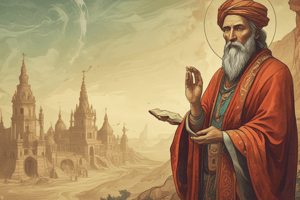Podcast
Questions and Answers
What does Durkheim believe is the true object of worship in religious rituals, according to his theory?
What does Durkheim believe is the true object of worship in religious rituals, according to his theory?
Society
What is the significance of totem poles in the context of Durkheim's theory?
What is the significance of totem poles in the context of Durkheim's theory?
They symbolize the clan's origins and create a feeling of solidarity
What criticism does Worsley (1956) raise against Durkheim's theory of religion?
What criticism does Worsley (1956) raise against Durkheim's theory of religion?
Many tribes share totems, and even if Durkheim is right about totems, it doesn't prove that he has found the essence of religion
How does Mestrovic (2011) argue that postmodern society affects Durkheim's theory of religion?
How does Mestrovic (2011) argue that postmodern society affects Durkheim's theory of religion?
What is the psychological function of religion, according to Malinowski (1954)?
What is the psychological function of religion, according to Malinowski (1954)?
In what two situations does Malinowski argue that religion promotes social solidarity?
In what two situations does Malinowski argue that religion promotes social solidarity?
What is the primary way that the ruling class maintains control over the working class, according to Gramsci?
What is the primary way that the ruling class maintains control over the working class, according to Gramsci?
What is Parsons' view on the role of religion in society?
What is Parsons' view on the role of religion in society?
According to Gramsci, what role can clergy play in helping workers see through the ruling class ideology?
According to Gramsci, what role can clergy play in helping workers see through the ruling class ideology?
What role does Parsons assign to religion in shaping society's values and meaning?
What role does Parsons assign to religion in shaping society's values and meaning?
What example does Parsons offer to illustrate how religion legitimates society's central values?
What example does Parsons offer to illustrate how religion legitimates society's central values?
What three ways did Billings identify in which religion was either supported or challenged by the employers' hegemony?
What three ways did Billings identify in which religion was either supported or challenged by the employers' hegemony?
What is the process identified by Wilson, whereby religious beliefs, practices, and institutions lose social significance?
What is the process identified by Wilson, whereby religious beliefs, practices, and institutions lose social significance?
What is the predicted church attendance percentage by 2015, according to Wilson?
What is the predicted church attendance percentage by 2015, according to Wilson?
What has been the trend in church attendance and participation in Britain over the past few years?
What has been the trend in church attendance and participation in Britain over the past few years?
What is the term used to describe the creation of a counter-hegemony by the lower classes to challenge the ruling class?
What is the term used to describe the creation of a counter-hegemony by the lower classes to challenge the ruling class?
What is the role of clergy, according to Gramsci, in helping workers create their own counter-hegemony?
What is the role of clergy, according to Gramsci, in helping workers create their own counter-hegemony?
What is the term used to describe the loss of social significance of religious beliefs, practices, and institutions?
What is the term used to describe the loss of social significance of religious beliefs, practices, and institutions?
What is the relationship between welfare spending and religious participation according to Gill and Lundegaarde (2004)?
What is the relationship between welfare spending and religious participation according to Gill and Lundegaarde (2004)?
Why do Gill and Lundegaarde (2004) believe that religion will not disappear completely?
Why do Gill and Lundegaarde (2004) believe that religion will not disappear completely?
What is a limitation of Gill and Lundegaarde's (2004) study?
What is a limitation of Gill and Lundegaarde's (2004) study?
What is the focus of religious fundamentalism?
What is the focus of religious fundamentalism?
What is the significance of an authoritative sacred text in religious fundamentalism?
What is the significance of an authoritative sacred text in religious fundamentalism?
How do fundamentalists tend to view themselves in relation to the rest of society?
How do fundamentalists tend to view themselves in relation to the rest of society?
What is the role of interpretation in understanding religious texts, according to Aldridge (2013)?
What is the role of interpretation in understanding religious texts, according to Aldridge (2013)?
What is the goal of fundamentalists, according to Davie (2013)?
What is the goal of fundamentalists, according to Davie (2013)?
What is a characteristic of religious fundamentalism, according to the text?
What is a characteristic of religious fundamentalism, according to the text?
What is the main distinction Castells (2011) makes between two responses to post-modernity?
What is the main distinction Castells (2011) makes between two responses to post-modernity?
What is Bruce's (2008) main argument regarding the cause of fundamentalism?
What is Bruce's (2008) main argument regarding the cause of fundamentalism?
What is the primary difference between fundamentalism in the West and in the Third World, according to the text?
What is the primary difference between fundamentalism in the West and in the Third World, according to the text?
What type of fundamentalism does Davie (2013) argue has emerged in recent decades?
What type of fundamentalism does Davie (2013) argue has emerged in recent decades?
What triggered the emergence of religious fundamentalism, according to the text?
What triggered the emergence of religious fundamentalism, according to the text?
What is the primary characteristic of monotheistic religions that makes them susceptible to fundamentalism, according to Bruce (2008)?
What is the primary characteristic of monotheistic religions that makes them susceptible to fundamentalism, according to Bruce (2008)?
What is the criticism of Giddens' approach to understanding fundamentalism?
What is the criticism of Giddens' approach to understanding fundamentalism?
What is a key difference between fundamentalist movements, according to the text?
What is a key difference between fundamentalist movements, according to the text?
What is the broader context in which fundamentalism emerges, according to the text?
What is the broader context in which fundamentalism emerges, according to the text?
What are the two new religious types emerging according to Hervieu-Leger?
What are the two new religious types emerging according to Hervieu-Leger?
What is the primary motivation of 'converts' according to Hervieu-Leger?
What is the primary motivation of 'converts' according to Hervieu-Leger?
What is the term used to describe the phenomenon of believing without belonging, according to Lyon?
What is the term used to describe the phenomenon of believing without belonging, according to Lyon?
What is the result of religious ideas becoming 'disembedded' from churches, according to Lyon?
What is the result of religious ideas becoming 'disembedded' from churches, according to Lyon?
What is the difference between 'religion online' and 'online religion', according to Hellend?
What is the difference between 'religion online' and 'online religion', according to Hellend?
What is the term used to describe individuals who pick and mix elements of different faiths to suit their tastes, according to Hervieu-Leger?
What is the term used to describe individuals who pick and mix elements of different faiths to suit their tastes, according to Hervieu-Leger?
What is the impact of globalisation on religion, according to Lyon?
What is the impact of globalisation on religion, according to Lyon?
What is the role of media in the postmodernist society, according to Lyon?
What is the role of media in the postmodernist society, according to Lyon?
What is the characteristic of postmodern society that has led to the emergence of new religious types, according to Hervieu-Leger?
What is the characteristic of postmodern society that has led to the emergence of new religious types, according to Hervieu-Leger?
Flashcards are hidden until you start studying
Study Notes
Durkheim's View of Religion
- Sacred things evoke powerful feelings due to how they represent something greater, which is society.
- Religious worship is, in essence, worship to society.
- To study something in great detail, we must study its origin, and for society, that would be a clan society (e.g., Arunta).
- Totem poles symbolize the clan's origins and create a feeling of solidarity, which means they are really worshipping society.
Functions of Religion
- Sacred symbols represent society's collective conscience, which maintains social integration and brings people together.
- To the individual, society makes us feel part of something greater than us.
- Malinowski (1954) argues that religion promotes social solidarity due to its psychological functions (helping them cope with emotional stress).
- Two situations in which religion promotes social solidarity: where the outcome is important but uncontrollable and uncertain (e.g., lagoon fishing vs. ocean fishing), and at times of life crises (e.g., birth, puberty, marriage, funeral rituals).
Parsons' View of Religion
- Parsons sees religion as a way to help people cope with unforeseen events and uncontrollable outcomes.
- Religion also creates and legitimates society's central values (e.g., Protestantism in the US sacralized the core American value of individualism) and is the primary source of meaning (answer to ultimate questions and gives meaning to lives).
Gramsci and Hegemony
- Gramsci was interested in how the ruling class used hegemony to maintain their control over the working class.
- Hegemony is never guaranteed in society due to the lower classes' ability to create their own counter-hegemony to challenge the ruling classes.
- Gramsci argues that popular forms of religion can help workers see through the ruling class ideology, and clergy can act as 'organic intellectuals' who teach the workers of their situation.
- Billings (1990) applies Gramsci's idea of hegemony to two groups of workers (coal miners and textile workers), identifying three ways in which religion was either supported or challenged by the employers' hegemony.
Secularisation in Britain
- In modern Britain, there are major changes concerning religion compared to 5 years ago: decline in church-going/belonging, fewer baptisms and church weddings, an increase in the age of average churchgoers, a decline in traditional Christian beliefs, and greater diversity.
- Wilson argues that western societies have undergone a long-term process of secularisation (a process whereby religious beliefs, practices, and institutions lose social significance).
- Wilson identifies that by 2015, only 5% of the adult population will attend church weekly, and Sunday school attendance has also declined further.
- Hervieu-Leger argues that two new religious types are emerging: pilgrims (those who follow their individual paths in search for self-discovery) and converts (those who join religious groups in order to belong to a community).
Postmodern Religion
- Lyon (2000) agrees that believing without belonging is becoming increasingly popular, stating that the postmodernist society we now live in is changing the nature of religion (e.g., globalisation, the importance of media, and the growth of consumerism).
- Religious ideas have become 'disembedded' from churches and spread across the media due to globalisation (e.g., televangelism).
- This has resulted in religion becoming deinstitutionalised, allowing people to adapt it for their own purposes.
- Hellend (2000) distinguishes two types of internet activity involving religious organisations: religion online and online religion.
- In postmodern society, people can pick and mix elements of different faiths to suit their tastes and make them part of their identity (e.g., 'spiritual shoppers').
- Europe has the highest rate of secularisation due to its equal society, whereas America is incredibly unequal, creating a greater need for religion.
Evaluation of Secularisation
- Gill and Lundegaarde (2004) found that the more a country spends on welfare, the lower the level of religious participation.
- They do not believe that religion will disappear completely due to the security needed from welfare provision, which doesn't answer all the ultimate questions that religion does.
Religious Fundamentalism
- Religious fundamentalism arises when traditional beliefs are threatened by modern society.
- Characteristics of fundamentalism include:
- An authoritative sacred text that gives objective truth and portrays the rules in which followers should follow.
- An 'us and them' mentality, where fundamentalist separate themselves from the rest of the world.
- Castells (2011) distinguishes between two responses to postmodernity: resistance identity (those who feel threatened and retreat to fundamentalism) and project identity (those who engage in social movements, feminism, and environmentalism).
Monotheism and Fundamentalism
- Bruce (2008) sees the main cause of fundamentalism as the perception of religious traditionalists that today's globalising world threatens their beliefs.
- He believes that fundamentalism is confined to monotheistic religions due to their notion of one God and one sacred text in which their ideas and beliefs are based.
- Differences in fundamentalism due to different origins: in the West, fundamentalism is seen as change taken place within a society, whereas in the Third World, it is a reaction to changes being thrust upon it from outside.
Secular Fundamentalism
- Davie (2013) argues that recent decades have seen the emergence of secular forms of fundamentalism, due to changes in modern society.
- These changes are distinguished in phases:
- The first phase gave rise to religious fundamentalism, which arose during the Enlightenment, where philosophy held an optimistic secular view introduced the power of science and human reason to improve the world.
Studying That Suits You
Use AI to generate personalized quizzes and flashcards to suit your learning preferences.



